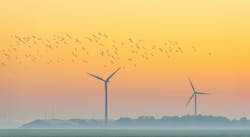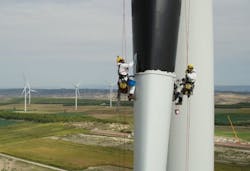Bird Call to Action: Wind Industry Taking New Paths to Protect Winged Creatures from the Blade
Wind turbines currently are the predominant new instrument of renewable energy resources in America, even starting to outpace longtime leader hydropower.
Thousands of elevated turbines generate more than 453 Terawatthours (TWh) of electricity annually in the U.S. Solar capacity is rising faster, but wind has overall utility-scale lead so far.
The clean energy impact of wind energy is net positive, with many offering a wave of support while others just might give the bird or a thumb down to the negatives.
Wind farms reportedly kill close to one million birds and bats per year in the U.S. alone, give or take a few hundred thousand according to various reports. While the avian body counts from wind blades pale in comparison to dangers such as automobiles, pesticides and cats, the turbine threat to birds is deadly significant and a serious barrier in public opinion for those who might want clean energy but value our feathered and webbed winged friends even more.
Understanding Siting from the Bird's Eye View
Location matters to many who want to reduce climate impacts of energy generation but also care for the safety and well-being of birds and bats.
“Climate change is a critical threat to birds,” reads an online statement by the American Bird Conservancy (ABC). “Recognizing this fact, ABC supports renewable energy, including wind energy, and the transition away from fossil fuels. However, not every wind project is proposed in a suitable location. Some projects—sited in major bird migration routes or stopover sites—threaten huge numbers of birds. Some areas of the country are better suited to the development of wind energy than others.”
The ABC’s pro-renewable energy stance is balanced by its willingness to swoop in and oppose projects sited in bird-sensitive areas. The conservancy has been successful in helping stop projects along the shores of Lake Erie as well as fighting the Mill Creek wind power project in Missouri.
The wind power industry is sometimes accused of perceived indifference to this problem by many American birders. However, the industry has taken some steps to try and reduce the death toll from turbine blades, including painting the blades back to be more visible, curtailing blade rotation when bats and birds are most active and siting wind farms in regions with less avian habitation.
“When assessing electricity generation technologies, it’s important to evaluate against baseline generation alternatives, because electricity generation is a requirement of modern society,” said Michael Howland, professor of civil and environmental engineering at the Massachusetts Institute of Technology, said in a posting on the MIT Climate Portal from a 2023 report. “Fossil fuels contribute to climate change, increased air pollution, and negative impacts on human and animal health, including birds, among other issues. Wind energy is an electricity generation technology that significantly reduces such environmental and health impacts.”
Using AI and Machine Vision to Protect Condors in Chile
Each of those remedies to reduce bird deaths from wind blades requires more study and cost-benefit analysis. A Colorado-based imaging company is trying a new solution beginning in South America to potentially mitigate the impact of wind energy on bird populations in famously biodiverse Chile.
Boulder Imaging is partnering with a distributor to try its IdentiFlight machine vision solution at wind farms in Chile. The company is working with its IdentiFlight distributor Aerovantage on deploying the vision technology among Chilean renewable energy projects.
The goal for using IdentiFlight is to reduce bird fatalities in wind farms by more than 85% across the world.
“Chile’s commitment to renewable energy must go hand in hand with protecting its rich biodiversity,” said Ricardo Jorquera, President of Aerovantage, in a statement announcing the collaboration with Boulder Imaging. “Our country is home to unique and vulnerable bird species, and the growth of wind energy requires innovative conservation measures. Partnering with IdentiFlight to deploy these advanced systems in Chilean wind farms ensures that our renewable energy expansion is sustainable and responsible.”
How IdentiFlight works is by using artificial intelligence and optical sensor technologies in tandem to detect and assess risks to sensitive bird species such as the native Andrean condor and the Chilean flamingo. If the system determines a collision risk is likely, IdentiFlight will trigger a temporary shutdown of impacted wind turbines, according to the companies.
Wind energy is growing huge in Chile, accounting for about 14% of the nation’s total installed power generation capacity and higher than the nearly 11% stake of wind energy in the U.S. Chilean wind capacity is forecast to more than double over the next 10 years.
About the Author
Rod Walton, EnergyTech Managing Editor
Managing Editor
For EnergyTech editorial inquiries, please contact Managing Editor Rod Walton at [email protected].
Rod Walton has spent 17 years covering the energy industry as a newspaper and trade journalist. He formerly was energy writer and business editor at the Tulsa World. Later, he spent six years covering the electricity power sector for Pennwell and Clarion Events. He joined Endeavor and EnergyTech in November 2021.
Walton earned his Bachelors degree in journalism from the University of Oklahoma. His career stops include the Moore American, Bartlesville Examiner-Enterprise, Wagoner Tribune and Tulsa World.
EnergyTech is focused on the mission critical and large-scale energy users and their sustainability and resiliency goals. These include the commercial and industrial sectors, as well as the military, universities, data centers and microgrids. The C&I sectors together account for close to 30 percent of greenhouse gas emissions in the U.S.
He was named Managing Editor for Microgrid Knowledge and EnergyTech starting July 1, 2023
Many large-scale energy users such as Fortune 500 companies, and mission-critical users such as military bases, universities, healthcare facilities, public safety and data centers, shifting their energy priorities to reach net-zero carbon goals within the coming decades. These include plans for renewable energy power purchase agreements, but also on-site resiliency projects such as microgrids, combined heat and power, rooftop solar, energy storage, digitalization and building efficiency upgrades.



